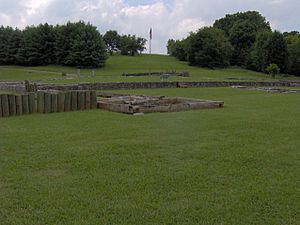Treaty of Tellico facts for kids
The Treaty With The Cherokee, 1798, also known as the First Treaty of Tellico, was an important agreement signed on October 2, 1798. It took place in a Cherokee village called Great Tellico in Tennessee, near a place called Tellico Blockhouse. This treaty was like an update or addition to an older agreement called the Treaty of Holston. It was also the only treaty made between the United States and Native American groups during the time John Adams was president.
Contents
Who Signed the Treaty?
The treaty was signed by two representatives from the United States: Thomas Butler and George Walton. On the Cherokee side, about 39 chiefs and warriors signed the document. Many people watched the signing, including Silas Dinsmoor, who was the United States' agent living among the Cherokee. An interpreter named Charles R. Hicks helped everyone understand each other.
What the Treaty Said
The treaty started by explaining why it was needed. It mentioned wanting to be fair to the Cherokee Nation and to keep both the Cherokee and the United States safe.
Key Agreements in the Treaty
Peace and Old Agreements
- Article 1: Both sides agreed to have peace, and they declared it would last forever.
- Article 2: All the old treaties between the United States and the Cherokee Nation would stay in full effect. This meant they would continue to follow those agreements.
New Land Boundaries
- Article 3: The borders of the Cherokee Nation's land would mostly stay the same, unless this new treaty changed them.
- Article 4: The Cherokee Nation officially gave up a large area of land to the United States. This land is now part of East Tennessee.
- Article 5: The new border line described in the treaty was to be marked right away. This line would then be part of the official boundary between the United States and the Cherokee Nation.
Payments and Promises
- Article 6: Because the Cherokee gave up land, the United States agreed to pay them $5,000 right away. They also promised to pay an extra $1,000 every year. The United States also promised to protect the rest of the Cherokee's country forever, as they had in earlier treaties.
Roads and Hunting Rights
- Article 7: A road known as the "Kentucky road," which went through a small part of Cherokee land, was made open for all United States citizens to use freely. In return, the Cherokee people were allowed to hunt on the land they had given up until too many settlements made it impossible.
Fair Dealings
- Article 8: The United States would let the Cherokee know when their annual payments were ready. They would also provide food for a reasonable number of Cherokee people who came to collect these payments.
- Article 9: If white people stole horses from the Cherokee, the United States would pay for them. If Cherokee people stole horses from white people, the cost would be taken out of the Cherokee's yearly payment.
- Article 10: The United States agent living among the Cherokee would be given enough land for his temporary use. Both sides promised to follow the treaty with good faith.


